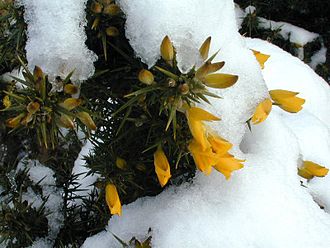Ulex

Ulex (commonly known as gorse, furze, or whin) is a genus of flowering plants in the family Fabaceae. The genus comprises about 20 species of thorny evergreen shrubs in the subfamily Faboideae of the pea family Fabaceae. The species are native to parts of western Europe and northwest Africa, with the majority of species in Iberia.
Gorse is closely related to the brooms, and like them, has green stems and very small leaves and is adapted to dry growing conditions. However it differs in its extreme thorniness, the shoots being modified into branched thorns 1–4 centimetres (1⁄2–1+1⁄2 inches) long, which almost wholly replace the leaves as the plant’s functioning photosynthetic organs. The leaves of young plants are trifoliate, but in mature plants they are reduced to scales or small spines.[2] All the species have yellow flowers, generally showy, some with a very long flowering season.
The most widely familiar species is common gorse (Ulex europaeus), the only species native to much of western Europe, where it grows in sunny sites, usually on dry, sandy soils. It is also the largest species, reaching 2–3 m (7–10 ft) in height; this compares with typically 20–40 cm (8–16 in) for western gorse (Ulex gallii). This latter species is characteristic of highly exposed Atlantic coastal heathland and montane habitats. In the eastern part of Great Britain, dwarf furze (Ulex minor) replaces western gorse. Ulex minor grows only about 30 cm (12 in) tall, a habit characteristic of sandy lowland heathland.
In full flower at Dalgarven Mill in Scotland.
Fruiting at Mallaig, Scotland
Common gorse flowers a little in late autumn and through the winter, coming into flower most strongly in spring. Western gorse and dwarf furze flower in late summer (August–September in Ireland and Great Britain). Between the different species, some gorse is almost always in flower, hence the old country phrase: “When gorse is out of blossom, kissing’s out of fashion”.[3] Gorse flowers have a distinctive coconut scent, experienced very strongly by some individuals, but weakly by others.[4][5]
Gorse may grow as a fire-climax plant, well adapted to encourage and withstand fires, being highly flammable,[9] and having seed pods that are to a large extent opened by fire, thus allowing rapid regeneration after fire. The burnt stumps also readily sprout new growth from the roots. Where fire is excluded, gorse soon tends to be shaded out by taller-growing trees, unless other factors like exposure also apply. Typical fire recurrence periods in gorse stands are 5–20 years.
Gorse thrives in poor growing areas and conditions including drought;[10] it is sometimes found on very rocky soils,[11] where many species cannot thrive. Moreover, it is widely used for land reclamation (e.g., mine tailings), where its nitrogen-fixing capacity helps other plants establish better.
Gorse is a valuable plant for wildlife, providing dense thorny cover ideal for protecting bird nests. In Britain, France, and Ireland, it is particularly noted for supporting Dartford warblers (Sylvia undata) and European stonechats (Saxicola rubicola); the common name of the whinchat (Saxicola rubetra) attests to its close association with gorse. The flowers are sometimes eaten by the caterpillars of the double-striped pug moth (Gymnoscelis rufifasciata), while those of the case-bearer moth Coleophora albicosta feed exclusively on gorse. The dry wood of dead gorse stems provides food for the caterpillars of the concealer moth Batia lambdella.
In many areas of North America (notably California and Oregon), southern South America, Australia, New Zealand, and Hawaii, the common gorse, introduced as an ornamental plant or hedge, has become an invasive species due to its aggressive seed dispersal; it has proved very difficult to eradicate and detrimental in native habitats. Common gorse is also an invasive species in the montane grasslands of Horton Plains National Park in Sri Lanka.[12]
